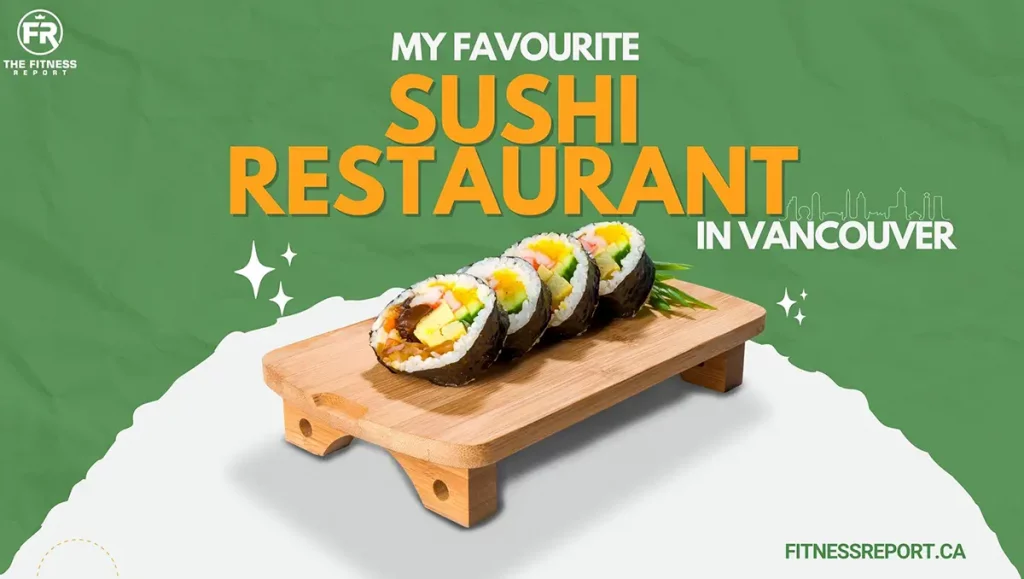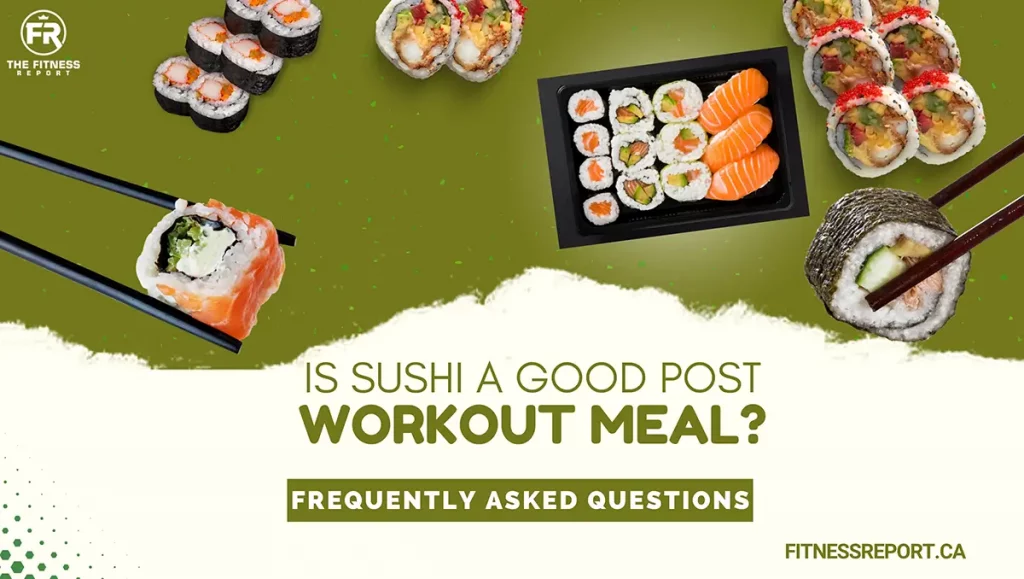Is Sushi A Good Post Workout Meal? Let’s Find Out!
There are several post workout meals and diets, but sushi is rarely a part of any of them. Japanese food, especially sushi often takes a backseat in this regard when in reality it is one of the best possible choices for a nutrient-rich workout meal.
A lot of people are already sushi fans which is why dedicated restaurants serving Japanese cuisine and even grocery stores always have sushi readily available. So, how is sushi beneficial, if we rule out convenience and taste?
Sushi is a good post workout meal because it is jam-packed with a ton of micronutrients and macros that are necessary for maintaining good health. Not only this, but it also has the right ratio of healthy fats, carbohydrates, and proteins that help in muscle/tissue repair after an intense workout.
Fish and rice are major components of sushi; the first one is rich in omega-3 fatty acids, vitamins, and magnesium while the latter offers glycogen to muscles for quick energy replenishment.
Sushi may also contain prawns, crab, eel, or other seafoods which are all an excellent sources of protein. Other Japanese dishes like Ramen and Bento Boxes apart from sushi also make use of a ton of vegetables and noodles which are a quick way to add good carbs to your diet.
Today, we shall look at how and why sushi is such a great post-workout meal and why it stands out. We will also cover how sushi consumption can be used to meet fitness goals and other nutritious Japanese dishes you must try. So, stick till the end to find out!
Sushi Is High In Protein

Sushi, generally, is a great source of protein. However, the percentage of proteins in sushi is dependent on the type of sushi you order like hand rolls, maki, etc. A sushi roll with tuna for example is rich in protein whereas hosomaki rolls with cucumbers have no protein content.
This makes it obvious that understanding and learning about various sushi types is the only way to deduce what kind is rich in proteins and which ones are not. The section below lists all the high-protein ingredients in sushi so you can pick a type that will be apt for a post-workout meal.
High Protein Ingredients In Sushi
The rice used in sushi does have protein but is not sufficient for it to be counted as a high-protein ingredient. A hundred grams of boiled rice has only around 2.4 grams of protein. Alternatively, nori which is the plant-made dry sheets used for sushi has thirty to fifty percent protein content.
Therefore, sushi with greater amounts of this ingredient is rich in proteins and perfect for your weight loss goals while sushi with tiny amounts of nori is not as protein-rich.
Let us look at the protein-rich ingredients used in sushi below:
Vegetables
Sadly, most vegetables used to make sushi are not very rich in protein. Due to this, a vegan sushi roll will likely have a lower protein content as compared to conventional/meat sushi rolls.
Edamame is a common vegetable used in Japanese dishes which is rich in minerals, proteins, and vitamins. This veggie is often used in sushi and just one cup holds around 18.46 grams of protein.
Avocados that are medium in size contain roughly around 4.02 grams of protein which makes it another protein-rich vegetable used in sushi. Other good sources of protein that are often added to sushi include fava beans, broccoli, mung beans, chickpeas, asparagus, and other legumes. Almonds and pistachios are protein-filled nuts that can also be added to sushi rolls to create an interesting texture.
Fish
Salmon, halibut, and tuna are common fish species used to make delicious sushi rolls. Salmon can be bought in various types and even smoked flavors. A hundred grams of salmon contains 20.4 grams of protein and is also rich in calcium, vitamin, and vitamin D.
Halibut is not as common for sushi but the ingredient is the perfect addition if you wish to consume a high-protein meal. A hundred grams of this fish has a whopping 21 grams of protein including tons of fatty acids, vitamins, and minerals.
Tuna has very large amounts of proteins, as high as 28 grams for just a hundred grams of the fish. Pollack on the other hand has 17.4 grams of protein with high levels of selenium, omega-3 fatty acids, and phosphorus which makes it a suitable ingredient for protein-rich sushi rolls. Another popular choice for sushi rolls is cod which has 17.5 grams of protein for each hundred grams of this fish.
Seafood
Fish is not the only seafood that is rich in proteins, other popular seafood sushi includes shrimp, squid, and scallops. A hundred grams of prawn contains 17.6 grams of protein while squid contain 10 grams. The best part is that these are also rich in vitamin B12 and omega-3 fatty acids.
Crustaceans like crabs and lobsters also make great protein-rich sushi rolls. Crabs contain 20 grams of protein per hundred grams. Lobster meat is more expensive but has 22.1 grams of protein in a 100 gram serving.
Best Sushi Rolls For Building Muscle 💪

Now that you know what ingredients you should look for if you want to indulge in protein-rich sushi, it is time to look at some popular sushi rolls that you can order or make for a great post-workout meal without hesitation.
Alaska Roll
The classic ingredients of the Alaska roll are fresh onions, avocado, and crab meat which is topped off with raw salmon slices. This forms the perfect uramaki bite with 3 sources of protein-filled ingredients.
Rainbow Roll
These rolls are another form of uramaki sushi that has rice as an outer layer with a filling of crab sticks, cucumbers, and avocado. Popular meat choices that are used to create the rainbow in this type of sushi roll include red snapper, salmon, eel, yellowtail, and tuna. The final protein count of the dish depends on the meats that have been selected.
Sashimi
Sashimi is not exactly a kind of sushi. Instead, it is thin slices of raw fish that are enjoyed with soy sauce. Most types of sashimi are therefore high in protein based on the type of fish that is served. The protein content of 100 grams of each fish type that is commonly served as sashimi is as follows:
- Sake (salmon) 20.4 grams
- Maguri (tuna) 21.4 grams
- Kani (crab) 20.5 grams
- Katsuo (bonito) 28 grams
- Ebi (sweet shrimp) 17.6 grams
- Hotate (scallops) 12 grams
- Ika (squid) 10 grams
- Uni (sea urchin) 11.5 grams
- Tako (octopus) 28.2 grams
- Saba (makerel) 22 grams
Tuna Roll
Tuna has an incredibly high protein content. Tuna rolls are therefore a great post-workout treat as these are made out of nori, rice, and raw tuna fish. Tuna rolls are often served with a side of mayonnaise or spicy sriracha. This combo is referred to as the spicy tuna roll. Tuna rolls are basically a form of roll-cut sushi, like uramaki that is high in protein and has a low carb content.
Other High Protein Japanese Foods To Try
If you think sushi is not the right choice for you, then fret not. Below are some other Japanese dishes that are rich in protein that you can opt for instead:
Edamame
Boiled edamame has nearly 18.46 grams of protein in a 100-gram cup. Edamame is whole, immature soybeans that are considered a vegetable. These beans are green in color as opposed to generic soybeans. Edamame is boiled with a tiny amount of salt to be served with salads, soups, stews, noodles, or as a snack alone. This vegetable is also served in sushi bars in both Japanese and Chinese cuisines.
Bento Boxes With Chicken Or Beef
A bento box is a single serving similar to a lunchbox. This box often contains rice or noodles along with meat, vegetables, fruit, yogurt, greek salads, fried potatoes, sandwiches, or dessert. Various portions are packed in separate containers inside a single box. Bento boxes with a side of chicken or beef are an excellent way to provide protein to your body.
You can also find them under the shidashi option in Japanese-style restaurants. Some fancy boxes may also have a side of fried gyoza, spring rolls, hand rolls with wasabi, tempuras, teriyaki, or even steamed shumai/dumplings.
Ramen Dishes
Ramen is a traditional Japanese noodle soup that is enjoyed in various parts of the world with different twists. This dish has broth as a base with thin and long wheat noodles that are served with an array of toppings based on choice. Shoyu ramen has a chicken broth with soy sauce, shio ramen is a lighter chicken soup seasoned with salt while miso ramen has a thicker broth that is rich brown in color thanks to a fermented soybean paste base.
Noodles in a ramen dish can also have various textures. These can be thin or thick and straight or curly. Thicker noodles are often served with a heavier broth and vice versa. All ramen noodles are made from wheat flour, water, salt, and kansui which gives them an elastic and chewy texture.
Apart from the broth, ramen can be served with protein-rich toppings like eggs, chicken, beef, dried seaweed, and steamed fish cakes. Some people even enjoy bamboo and scallion toppings.
Udon Dishes
Udon dishes, also known as yaki udon in Japanese, are made from noodles, soy sauce, meat, and vegetables. The udon noodles are thick, white, and smooth and are stir-fried with lots of protein-rich vegetables and meat to create a delectable treat. The texture of noodles is similar to that of ramen.
My Favorite Sushi Restaurants In Vancouver & The Lower Mainland

A few sushi restaurants that I personally love and can vouch for are:
Sushi Mugen
Location: 903 Davie Street, Vancouver, BC, Canada
This one is my personal favorite and tops my list of sushi restaurants. Sushi Mugen is open from Sunday to Monday between 11:30 AM and 10:00 PM. You can order takeout from a special menu, get food delivered, or dine in as per your choice.
This Japanese restaurant has a wide menu serving appetizers, sushi, udon, and a lot more. My personal favorites are seafood udon, tuna sashimi, and sockeye salmon sushi. All of these make for great protein-rich meals.
Toshi
Location: 181 E 16th Ave, Vancouver, BC V5T 4R2, Canada
Toshi Sushi also offers dine-in, takeout, and delivery so you can enjoy Japanese cuisine anywhere you like. My personal favorites are the sushi combinations, assorted sashimi, and teriyaki chicken don. Their rates are reasonable and their servings are always nutrient-rich and fulfilling.
Miku
Location: 200 Granville St #70, Vancouver, BC V6C 1S4, Canada
Miku is a well-known sushi restaurant in Vancouver that I love for takeout and home delivery. The restaurant provides comfort Japanese food for days when I do not wish to leave my house. My personal favorites are the chicken katsu and traditional sushi platter.

Is Sushi A Good Post Workout Meal: Frequently Asked Questions (FAQs)
Conclusion
Sushi and other protein-rich Japanese dishes can make excellent post workout meals given that you do not indulge in an array of caloric sauces and fried foods. Not only is sushi lower in calories, but it’s also a great way to replenish good carbs, add omega-3 fatty acids to your diet and aid muscle growth due to its high protein content.

